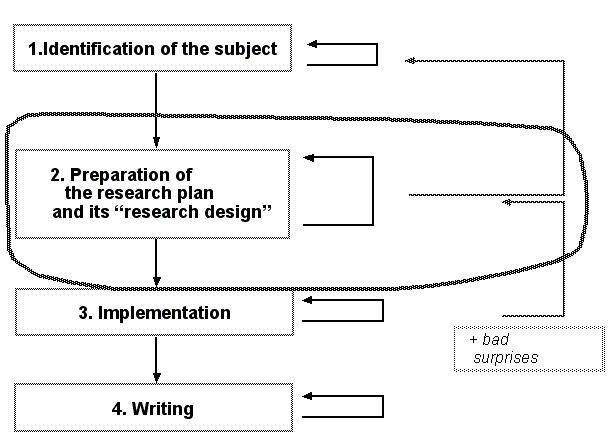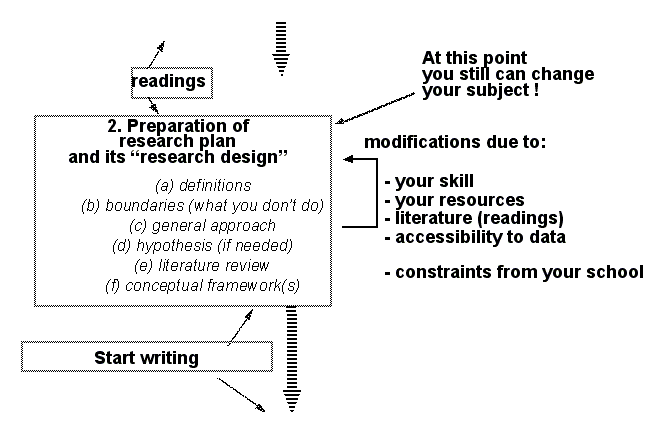Methodology tutorial - the research plan: Difference between revisions
m (using an external editor) |
m (using an external editor) |
||
| Line 23: | Line 23: | ||
== Elements of a typical research plan == | == Elements of a typical research plan == | ||
* Note: You may have to adapt this list to fit formal requirements from your institution | * Note: You may have to adapt this list to fit formal requirements from your institution or methodology constraints. As you will see later, various research types do implement a somewhat different logic and form. | ||
or methodology constraints . | |||
=== Element: Your research subject === | === Element: Your research subject === | ||
| Line 36: | Line 35: | ||
=== Element: Objectives of your research === | === Element: Objectives of your research === | ||
* Say clearly what you wish to achieve | * Say clearly what you wish to achieve, because this will determine research questions and/or hypothesis. | ||
* Valorization (if appropriate): how can you transfer results in a "real context" ? | * Valorization (if appropriate): how can you transfer results in a "real context" ? | ||
| Line 61: | Line 59: | ||
* In theory-oriented research, formulate hypothesis that postulate causalities | * In theory-oriented research, formulate hypothesis that postulate causalities | ||
** Bad: "I postulate that my e-learning design will work" | ** Bad: "I postulate that my e-learning design will work" | ||
** Good: "Conditions for successful implementation of an e-learning design in the context | ** Good: "Conditions for successful implementation of an e-learning design in the context XXX of are ....." | ||
XXX of are ....." | |||
** Bad: "ICT doesn’t work in schools" | ** Bad: "ICT doesn’t work in schools" | ||
** Good: "Critical variables A, B, C for successful implementation of e-learning are ...". | ** Good: "Critical variables A, B, C for successful implementation of e-learning are ...". Then, make explicit A, B, C as causal rules. | ||
=== Element: Approach & methodology === | === Element: Approach & methodology === | ||
* | * Description of your overall approach (for example "experimental design", "survey study", "usability study", "instructional design") | ||
* Description of data gathering and analysis techniques (for example, semi-directive interviews, content analysis ...) | * Description of data gathering and analysis techniques (for example, semi-directive interviews, content analysis ...) | ||
Note: Make sure to explain your methodological designs for all levels of analysis ! | Note: Make sure to explain your methodological designs for all levels of analysis ! | ||
* at the organizational level (if you are interested in this question), | |||
* at the individual level (e.g. students, teachers) | |||
Basic principle: | Basic principle: | ||
* show convincingly '' how you are going to answer each research question !'' | * show convincingly '' how you are going to answer each research question !'' | ||
* Obey guidelines dictated by the general approach | * Obey guidelines dictated by the general approach | ||
| Line 119: | Line 113: | ||
=== Major elements must be linked together === | === Major elements must be linked together === | ||
[[ | [[image:methodology-research-plan-as-whole.png|frame|none|The research plan as a whole]] | ||
=== Recall: Research plan = what + why: === | === Recall: Research plan = what + why: === | ||
Revision as of 20:43, 3 September 2008
This article or section is currently under construction
In principle, someone is working on it and there should be a better version in a not so distant future.
If you want to modify this page, please discuss it with the person working on it (see the "history")
<pageby nominor="false" comments="false"/>
Research Design for Educational Technologies - The research plan
This is part of the methodology tutorial.
Place of the research plan
Important elements of the research plan
Anticipation of main research activity (implementation)
Elements of a typical research plan
- Note: You may have to adapt this list to fit formal requirements from your institution or methodology constraints. As you will see later, various research types do implement a somewhat different logic and form.
Element: Your research subject
- the big question (general subject in one sentence)
- explicitation of the big question
- at least a few sentences that demonstrate its practical and theoretical interests.
- motivations and various ends
- delimitations (what you are not going to do)
Element: Objectives of your research
- Say clearly what you wish to achieve, because this will determine research questions and/or hypothesis.
- Valorization (if appropriate): how can you transfer results in a "real context" ?
Element: theory
- Start with a short and synthetic text describing and discussing the "state of the art" in your subject area.
- Be sure to mention the major publications. Read the ones you quote from !
- You may point out inconsistencies and gaps (adds additional interest to your project !)
- Identify theories and conceptual models that you will use.
- Maybe add your modifications and present both at the end
- Make sure that you define all concepts
- A lot of concepts are controversial, e.g. pedagogical effectiveness, efficiency, ...
Element: Research questions and/or hypothesis
Make explicit your research subject, main goal and objectives
Choose from (or combine):
- Open research questions (but make an effort to be as precise as possible).
- Research questions formulated as working hypothesis.
- Real hypothesis that are based on theory.
- In theory-oriented research, formulate hypothesis that postulate causalities
- Bad: "I postulate that my e-learning design will work"
- Good: "Conditions for successful implementation of an e-learning design in the context XXX of are ....."
- Bad: "ICT doesn’t work in schools"
- Good: "Critical variables A, B, C for successful implementation of e-learning are ...". Then, make explicit A, B, C as causal rules.
Element: Approach & methodology
- Description of your overall approach (for example "experimental design", "survey study", "usability study", "instructional design")
- Description of data gathering and analysis techniques (for example, semi-directive interviews, content analysis ...)
Note: Make sure to explain your methodological designs for all levels of analysis !
- at the organizational level (if you are interested in this question),
- at the individual level (e.g. students, teachers)
Basic principle:
- show convincingly how you are going to answer each research question !
- Obey guidelines dictated by the general approach
- in particular: be careful with experimental designs (rules are strict !)
- (more details below)
Approach
- Briefly describe the overall approach you are using
- Discuss analysis grids that will measure important concepts
- You also can discuss conceptual frameworks (if not done before)
- For experimental studies: clearly describe the experimental conditions
Measures and material
- Data gathering techniques: (interviews, observations, surveys, ....)
- Sampling strategies (or justification of singular case selection)
- For qualitative in-depth studies
- sampling of interviews, events, etc.
- For experimental studies
- there is a strict way of doing things ! You have to describe in detail experimental conditions, materials used, sampling conditions etc.
Analyses
- Shortly describe analysis techniques (both qualitative and quantitative)
- If necessary: point out which methods need development (e.g. analysis of student-student interaction in a CSCW environment)
Element: Information sources
- Bibliography (use a real standard, like APA !)
- Documents to analyze
- Information interviews, etc., ....
Element: Work Agenda
(see module [Methdology tutorial - planning techniques])
The research plan is a whole
Major elements must be linked together
Recall: Research plan = what + why:
|
What ? |
A good question ! |
|
|
A (or more) good conceptual framework(s) |
| |
|
How? |
Consider that your research plan should be ... |
(and nothing else!)
questions. |
|
Be realistic !Prove that you have ... |
| |
|
A whole ! |
Integration ! |
|
Before you believe that your are done
Check again:
- Theoretical feasibility
- You can’t do it all by yourself, check the literature (if not already done so, find "ground breaking" articles)
- In particular: theoretical frameworks, analysis grids, theoretical statements.
- organize an interview with a least an academic and a domain expert
- Inventory of approaches and methods
- there are some constraints, you can’t study everything in any way (but you do have choice !)
- finding a good design always is an iterative process (so don’t worry if your first version looks bad)
- Identify your main approach :
- look at similar research
- if you want to prove things and make causality claims, you need comparison !
- use qualitative approaches to explore and to understand, quantitative to confirm, generalize, prove, ...
- Methodological feasibility
- Dress a list of all the concepts that appear in your research questions (and hypothesis if you have)
- Take each concept apart for its dimensions,
- Operationalize each empirical dimension (make it is measurable)
- Does your theory part really relate to your empirical / practical part ?
- Make sure that you can produce needed data and then analyze them
- do you know how to gather data (make observations, design questionnaires, make interviews, ...
- can you handle these data ?



